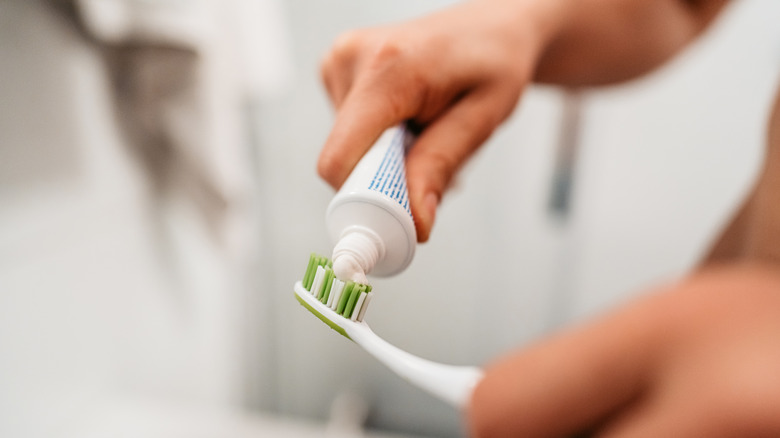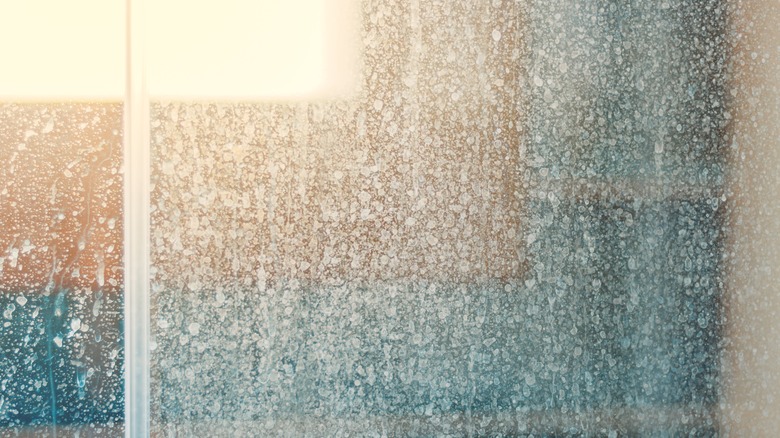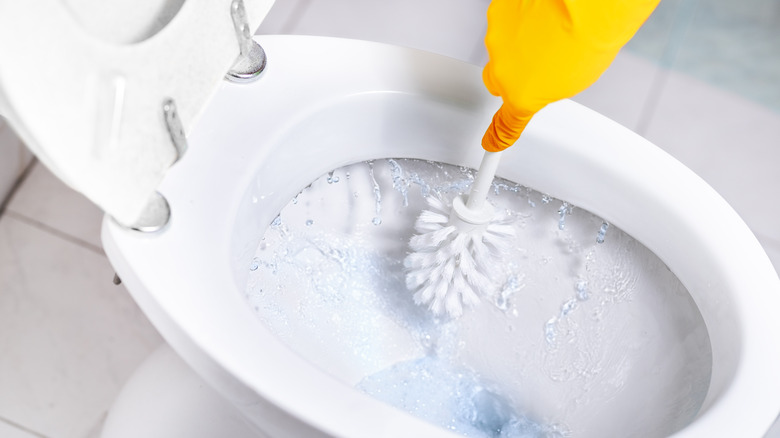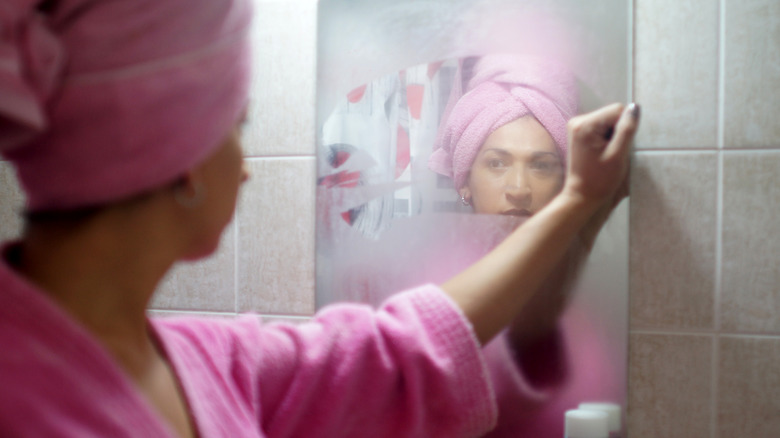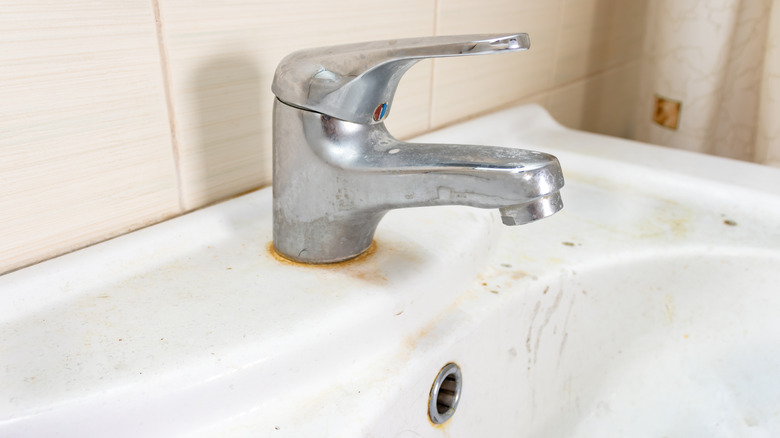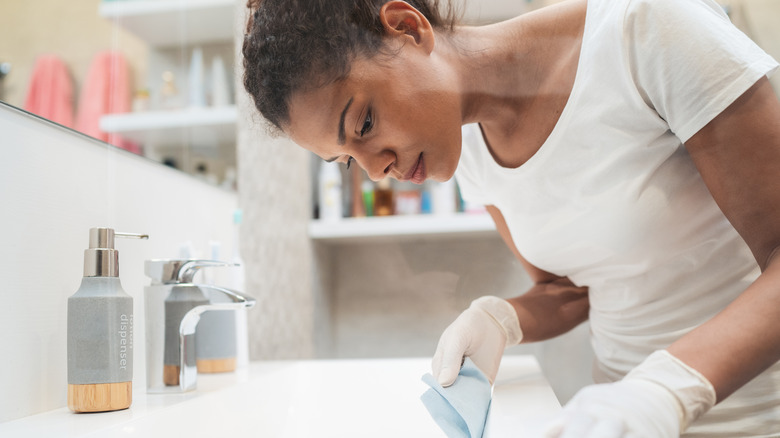All The Spots In Your Bathroom You Should Being Cleaning With Toothpaste
Have you ever used the phrase: if it's good enough for my teeth, it's good enough for my bathroom? If you haven't, these tips might just give you a reason to quote that because toothpaste can actually serve a variety of cleaning purposes in your washroom. Not only does this solution protect your teeth from cavities, bacteria, and stains, but your standard tube can help remove daily wear and tear within one of the most used spaces in your house, and it lives right inside your bathroom for easy access!
Whether you're constantly fighting hard water stains or just want a hack that keeps your mirrors from fogging up, using your preferred brand of toothpaste around the house might be your new solution for a variety of cleaning needs. By using it to combat bothersome bathroom issues like rust, you might not have to use as many harsh chemicals to keep this area sparkling. Just make sure you always separate your cleaning toothbrush from the one you use on your teeth—that's one cleaning faux pas you might not forget.
Toothpaste can battle stains on your teeth and hard water stains
If your bathroom fixtures and appliances expel hard water, you might find that stubborn water stains on your glass surfaces are part of daily life. Calcium and magnesium build up over time on glass surfaces, creating marks and spots that are difficult to remove with just water and soap. Although there are several methods to get rid of hard water stains, among the most efficient ways is by scrubbing them with toothpaste. The key is to use non-gel solutions, as the fluoride in the alternative will work harder to combat and eliminate hard water marks.
Add a small squeeze of toothpaste to your glass where limescale build-up is prevalent, then use a sponge to gently rub it into the stains. You can let the paste sit for a few minutes before wiping it off and rinsing the surface with water.
Porcelain as white as your teeth thanks to toothpaste
Unsightly toilet stains can ruin a bathroom aesthetic, and if you pride yourself on an aesthetically pleasing finish in this area, chances are you want to avoid a dirty-looking toilet at all costs. Just like teeth that can suffer from stains and plaque build-up, toilets are prone to discoloration, but a little toothpaste can rid the bowl of marks and leave it sparkling. While toothpaste won't disinfect your toilet, it can remove stains when used as a scrub with a toilet brush.
Pour toothpaste along the inside of the bowl, around the rim, and even under the seat and lid. Avoid using gel formulas; once you've scrubbed the bowl clean, allow the paste to sit for two to four hours before rinsing with fresh water to ensure the fluoride eats away at all the staining. Use a toilet brush to scrub away any toothpaste residue, as it can leave behind a chalky layer that might keep your toilet looking dirty even though the stains are gone. Use this toilet-cleaning hack whenever your porcelain needs some sparkle!
Stop a steamy mirror with a little toothpaste coating
A nice, steamy shower certainly feels amazing, but if you plan on using the mirror afterward, that fog could put a stop to that until you air out the room. Turning on the vent fan can help, but sometimes a steamy mirror takes a little too long to go back to normal, which is why this clever toothpaste hack might just save you some time and frustration. As a surfactant, non-gel-based paste can keep moisture from collecting on your mirror's surface, allowing for an easy clean when you're done in the shower.
To help fight fog, rub toothpaste over your mirror and remove it completely with a clean cloth. Though it's unlikely that gritty or abrasive formulas will scratch your glass, it's best to avoid them. Try this trick with Crest Cavity Protection or Sensodyne since these paste-based formulas provide the best results.
Rid your bathroom of rust
Have you noticed rust stains around the drains in your bathroom? Rust can be found wherever moisture collects and oxygenates around iron fixtures, which tends to happen in washrooms more often than not. While toothpaste can't stop rust in its tracks, it's great for getting rid of surface rust that could otherwise leave your bathroom looking grimy.
To remove rust stains, combine one part toothpaste with one part baking soda to form a thick solution that can be scrubbed into rust stains with an old toothbrush or microfiber cloth. Let the paste soak on the stains for up to ten minutes before you work at it, and repeat the process if some rust coloration remains. Use a fresh cloth and clean, cool water to wipe away all the toothpaste residue once you're happy with the rust-free surfaces that look as white as the day they were installed.
The proof is in the paste when it comes to spotless sinks
Your sink can quickly become one of the dirtiest fixtures in the bathroom, rivaling even the toilet for stains and build-up. Toothpaste can help rid your porcelain of soap scum, hard water stains, and the apparent toothpaste residue left behind from brushing. The same fluoride in toothpaste that helps brighten and whiten teeth can help leave your sink sparkling after a good scrub, fighting off these marks to leave the surfaces as good as new.
For the best results, add non-gel toothpaste to a toothbrush used just for cleaning, and work the bristles against the stains until they disappear. Don't push too hard or use a brush with thicker pieces of plastic (like those with specialized plaque removers), as these may scratch your sink. Once you're done scrubbing, rinse away all of the toothpaste so no residue remains. Your sink will appear spotless with the same solution you wash down the drain whenever you brush — the irony is not lost, but the proof is in the paste!
